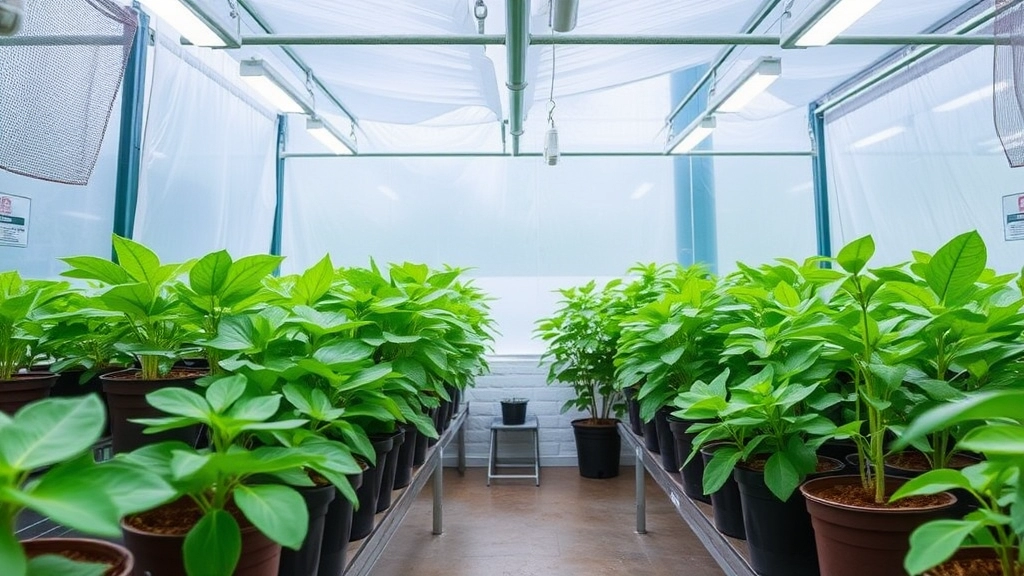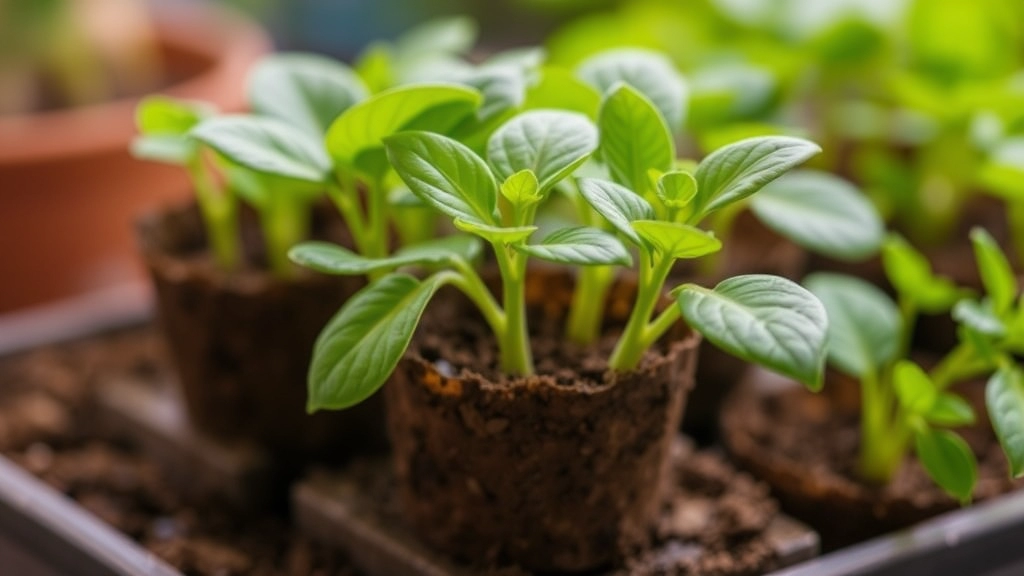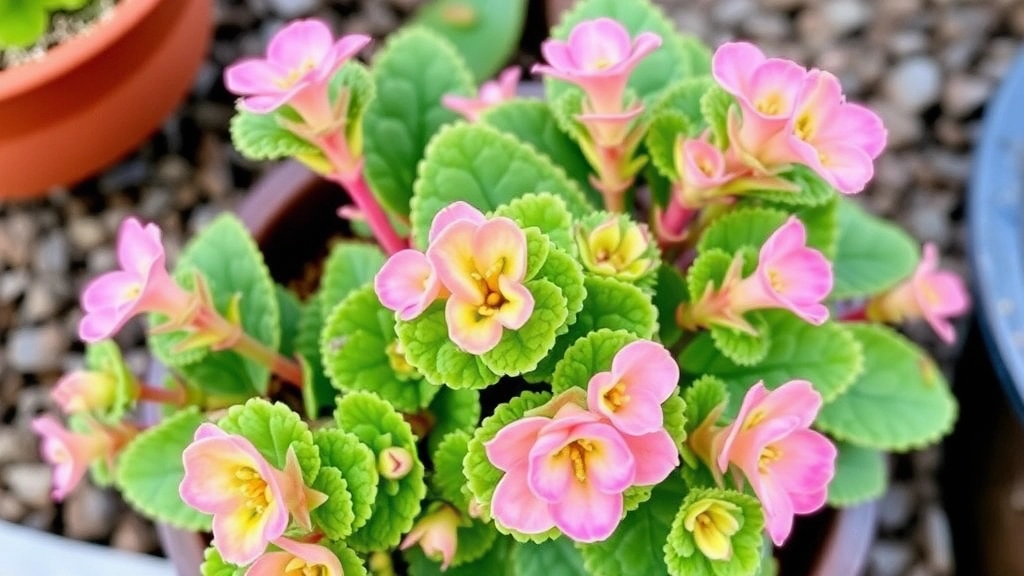Taking Care of Your Kalanchoe Mother of Thousands
Taking care of your Kalanchoe Mother of Thousands can be a rewarding experience. This unique plant, known for its prolific baby plantlets, thrives with the right care. Let’s dive into the essentials, starting with choosing the perfect light and location. Ensuring your plant gets ample indirect sunlight will help it flourish without getting scorched. A sunny windowsill with filtered light is ideal.
Soil and Watering
Next, focus on the soil. A well-draining mix is crucial for the Mother of Thousands. Think cactus or succulent soil with added perlite for extra drainage. Watering is another key aspect; let the soil dry out completely between waterings to prevent root rot. Remember, this plant prefers a ‘less is more’ approach when it comes to water. Follow these tips, and your Kalanchoe will thrive, adding a touch of green to your home.
Choosing the Right Light and Location for Your Mother of Thousands
When it comes to nurturing your Mother of Thousands, selecting the proper light and location is crucial. Many plant enthusiasts often wonder why their succulents aren’t thriving. The answer often lies in their environment.
Ideal Light Conditions
Mother of Thousands (Kalanchoe daigremontiana) flourishes in bright, indirect sunlight. Here are some key points to consider:
- Direct Sunlight: While some direct sunlight is beneficial, too much can scorch the leaves. Aim for 4-6 hours of bright light daily.
- Filtered Light: A location near a window with sheer curtains can provide the perfect balance of light.
- Low Light: If your plant is in a low-light area, it may become leggy and weak. Consider moving it to a brighter spot.
Location Matters
Choosing the right location in your home can significantly impact the health of your Mother of Thousands. Here are some suggestions:
- South or West-Facing Windows: These spots typically receive the most sunlight, making them ideal for your plant.
- Avoid Cold Drafts: Keep your plant away from doors and windows that open frequently, as cold drafts can stress it.
- Indoor vs. Outdoor: If you choose to place your plant outdoors, ensure it’s in a shaded area during the hottest part of the day. For more detailed information on this topic, check out our indoor vs. outdoor care guide.
For those looking to expand their succulent collection, consider exploring other fascinating varieties like the Kalanchoe Tomentosa Nigra, which also thrives under similar light conditions.
Best Soil Mix for Healthy Growth

So, you’ve got your Mother of Thousands and you’re wondering what soil will keep her thriving, right?
Choosing the right soil mix is crucial for her health and growth.
Why Soil Matters
Good soil is like a comfy bed for your plant. It helps with drainage, aeration, and provides the nutrients she needs.
Here’s what I recommend for the perfect mix:
- Cactus or Succulent Mix: This is a great base. It’s designed to drain well, which is super important for Mother of Thousands.
- Perlite or Pumice: Adding about 20-30% of this will improve drainage and aeration.
- Organic Matter: A bit of compost can give her a nutrient boost. Just don’t overdo it, or you’ll risk root rot.
DIY Soil Mix Recipe
If you’re feeling adventurous, here’s a simple DIY recipe:
- 50% cactus/succulent mix
- 30% perlite or pumice
- 20% compost
Mix it all together and you’re good to go!
Signs of Poor Soil
If you notice yellowing leaves or mushy roots, it’s time to reconsider your soil choice.
Remember, Mother of Thousands thrives in a well-draining environment.
How to Water Mother of Thousands Correctly
Watering your Mother of Thousands can be a bit tricky.
You might be wondering, “How much water does my plant really need?” or “Am I overwatering it?”
These are common concerns among plant enthusiasts.
Understanding Watering Needs
Mother of Thousands, also known as Kalanchoe daigremontiana, thrives in well-draining soil and is highly susceptible to root rot if overwatered.
Here’s how to ensure you’re watering correctly:
- Check the Soil: Before watering, always check the top inch of the soil. If it feels dry, it’s time to water.
- Watering Technique: Use a watering can with a narrow spout. This allows you to direct water precisely at the base of the plant, avoiding the leaves.
- Amount of Water: Water until it drains out of the bottom of the pot. This ensures that the roots are getting enough moisture.
- Frequency: During the growing season (spring and summer), water every 2-3 weeks. In the dormant season (autumn and winter), reduce this to once a month.
Signs of Overwatering
Keep an eye out for these signs:
- Yellowing leaves
- Wilting despite wet soil
- A foul smell from the soil
If you notice any of these, it might be time to adjust your watering schedule. For more detailed care tips, you can refer to the complete guide to Kalanchoe Mother of Thousands care and propagation. Additionally, understanding the different varieties and traits of Kalanchoe succulents can help you better care for your plant.
Temperature and Humidity Needs for Optimal Growth

When it comes to nurturing your Mother of Thousands, understanding its temperature and humidity preferences is crucial. You might be wondering, “What temperature does my plant need to thrive?” or “How humid should my home be for optimal growth?” Let’s delve into these essential factors.
Ideal Temperature Range
Mother of Thousands (Kalanchoe daigremontiana) flourishes in warm environments. Here are the key temperature guidelines:
- Daytime Temperature: Aim for a range of 20°C to 30°C (68°F to 86°F).
- Nighttime Temperature: A slight drop to 15°C to 20°C (59°F to 68°F) is beneficial.
- Avoid Extremes: Temperatures below 10°C (50°F) can stress the plant, leading to stunted growth or even death.
Humidity Levels
While Mother of Thousands is quite resilient, it prefers moderate humidity levels. Here’s what to keep in mind:
- Optimal Humidity: A humidity level of 40% to 60% is ideal.
- Avoid Excess Moisture: High humidity can lead to fungal issues, so ensure good air circulation.
- Dry Environments: If you live in a dry area, consider using a humidity tray or a small humidifier.
Practical Tips for Maintaining Conditions
- Monitor Temperature: Use a thermometer to keep track of the temperature in your plant’s location.
- Adjust Placement: If your plant is near a drafty window or heater, consider moving it to a more stable environment.
- Check Humidity: A hygrometer can help you monitor humidity levels accurately.
Fertilizing Tips: How Often and What Type to Use
When caring for your Mother of Thousands, you may wonder how to keep it thriving through proper fertilisation.
Why Fertilising Matters
Fertilising is crucial for the overall health and growth of your plant. It provides essential nutrients that may be lacking in the soil, allowing your Mother of Thousands to flourish.
Propagation Methods: Plantlets and Cuttings

So, you’re ready to expand your collection of Mother of Thousands? Great choice! These plants are a joy to propagate, and it’s easier than you might think.
Understanding Plantlets
One of the coolest things about Mother of Thousands is its ability to produce tiny plantlets right on the edges of its leaves. These little guys are nearly ready to grow on their own, making propagation a breeze.
Here’s how to do it:
- Choose Healthy Leaves: Look for leaves that are plump and healthy.
- Gently Remove: Use clean scissors to snip off the leaf, making sure to include the plantlets.
- Let Them Callous: Before planting, let the cuttings dry out for a day or two. This helps prevent rot.
- Plant in Soil: Place the leaf flat on top of well-draining soil.
Using Cuttings
If you want to take a different approach, cuttings are also a solid option. Here’s a simple guide:
- Select a Stem: Pick a healthy stem with a few leaves.
- Make the Cut: Cut just below a leaf node, about 4-6 inches long.
- Let It Dry: Just like with plantlets, let the cutting sit for a day to callous.
- Plant: Stick it in soil, ensuring it’s stable.
Caring for Your New Plants
Once you’ve planted your new additions, here’s what to keep in mind:
- Light: Keep them in bright, indirect light.
- Watering: Only water when the soil is dry to the touch.
- Patience: It might take a few weeks for roots to establish.
Repotting and Managing Overgrowth
As we explore the care of your Mother of Thousands, repotting and managing overgrowth are essential tasks that ensure your plant thrives.
When to Repot
You might wonder, “How do I know when to repot my Mother of Thousands?”
Here are some signs to look out for:
- Root Bound: If you notice roots growing out of the drainage holes or circling the pot, it’s time for a new home.
- Stunted Growth: A sudden halt in growth can indicate that the plant has outgrown its current pot.
- Soil Degradation: If the soil appears compacted or depleted of nutrients, consider repotting.
Choosing the Right Pot
When selecting a new pot, keep these tips in mind:
- Size: Choose a pot that is one size larger than the current one. Too large a pot can lead to overwatering.
- Drainage: Ensure the pot has sufficient drainage holes to prevent root rot.
Repotting Steps
- Prepare Your Materials: Gather a new pot, fresh soil mix, and tools.
- Remove the Plant: Gently take the plant out of its old pot, taking care not to damage the roots.
- Inspect the Roots: Trim any dead or rotting roots before placing the plant in its new pot.
- Add Soil: Fill the new pot with soil, positioning the plant at the same depth it was in the old pot.
- Water: Give it a good drink to help settle the soil.
Managing Overgrowth
Mother of Thousands can become quite prolific, often producing numerous plantlets. To manage this overgrowth effectively:
- Regular Pruning: Trim back any excess growth to maintain a manageable size and encourage bushier growth.
- Propagation: Use the plantlets you remove during pruning to propagate new plants. For more detailed steps, check out our guide on propagating Kalanchoe Blossfeldiana cuttings.
By keeping your Mother of Thousands in check, you not only ensure its health but also create opportunities for new plants. For additional tips on care, visit our complete guide on caring for Panda Plant.
Common Issues and Troubleshooting (Pests, Leaf Problems, etc.)
So, you’ve got your Mother of Thousands thriving, but waitâwhat’s that?
Are those little bugs crawling on your plant, or is it a case of wilting leaves?
Don’t worry; we’ve all been there, and I’m here to help you troubleshoot these common issues.
Pests
First up, let’s talk about pests.
These little critters can be a real nuisance, but identifying them early can save your plant.
- Mealybugs: These white, cottony blobs love to hide in leaf joints.
- Solution: Wipe them off with a cotton swab dipped in rubbing alcohol.
- Spider Mites: Tiny and often invisible, they leave webbing behind.
- Solution: Increase humidity or spray with insecticidal soap.
- Aphids: Small green or black bugs that suck sap.
- Solution: A strong spray of water can dislodge them.
Leaf Problems
Next, let’s tackle those pesky leaf problems.
Yellowing or drooping leaves can be a sign of several issues.
- Overwatering: If the leaves are yellow and mushy, you might be giving your plant too much love.
- Solution: Allow the soil to dry out completely before watering again.
- Underwatering: Conversely, if the leaves are shrivelling, it’s time to hydrate.
- Solution: Give it a good drink and check your watering schedule.
- Leaf Spots: Brown or black spots can indicate fungal infections.
- Solution: Remove affected leaves and ensure good air circulation.
Additional Tips
- Always inspect your plant regularly to catch issues early.
- Keep your tools clean to avoid spreading pests or diseases.
- Rotate your plant occasionally for even light exposure.
For more detailed care tips, check out our Complete Guide to Kalanchoe Mother of Thousands Care & Propagation. If you are facing issues with other Kalanchoe varieties, you might find our Expert Tips on How to Care for a Kalanchoe Succulent useful.
FAQs on Kalanchoe Mother Of Thousands Care
What is the best soil mix for Mother of Thousands?
The ideal soil mix includes a base of cactus or succulent mix, with 20-30% perlite or pumice for improved drainage and aeration, and a small amount of compost for nutrients. A simple DIY recipe is 50% cactus/succulent mix, 30% perlite or pumice, and 20% compost.
Why is well-draining soil important for Mother of Thousands?
Well-draining soil helps prevent root rot and ensures that the plant receives adequate aeration. Poor drainage can lead to yellowing leaves and mushy roots.
What temperature range is ideal for Mother of Thousands?
Mother of Thousands thrives in daytime temperatures of 20°C to 30°C (68°F to 86°F) and nighttime temperatures of 15°C to 20°C (59°F to 68°F). Avoid temperatures below 10°C (50°F) as they can stress the plant.
What are the humidity requirements for Mother of Thousands?
The plant prefers moderate humidity levels of 40% to 60%. High humidity can lead to fungal issues, so ensure good air circulation. In dry environments, consider using a humidity tray or a small humidifier.
How can I propagate Mother of Thousands?
You can propagate Mother of Thousands using plantlets or cuttings. For plantlets, choose healthy leaves, let them callous, and place them on well-draining soil. For cuttings, select a healthy stem, let it dry, and plant it in soil.
What are plantlets and how do I use them for propagation?
Plantlets are tiny plants that grow on the edges of the leaves of Mother of Thousands. To propagate, gently remove a healthy leaf with plantlets, let it callous, and place it on well-draining soil.
How do I care for new plants after propagation?
Keep the new plants in bright, indirect light and water only when the soil is dry to the touch. Be patient, as it might take a few weeks for the roots to establish.
References
-
Mother of Thousands Plant Care – Gardening Know How
-
Growing Mother of Thousands Plant – The Spruce
-
Mother of Thousands Care Tips – Better Homes & Gardens
